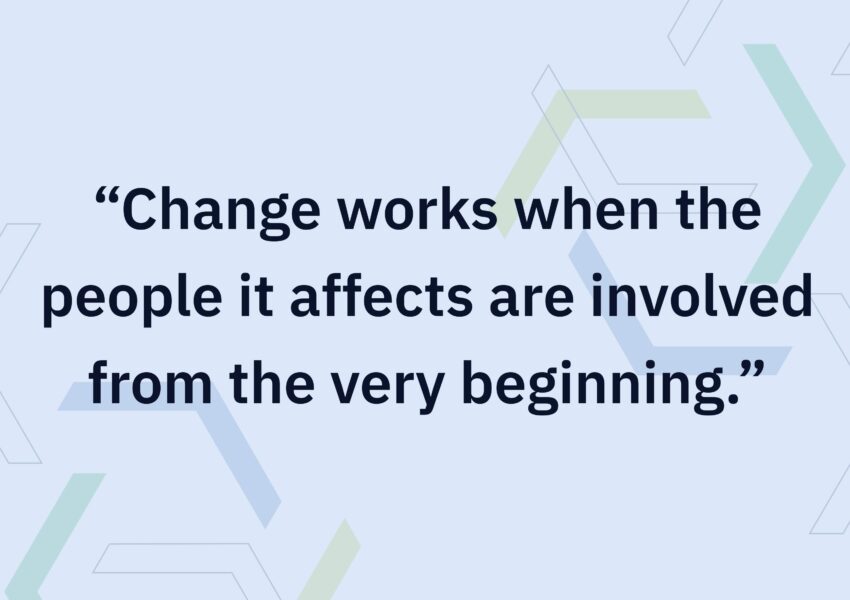Beyond the demo: what actually happens when you digitise the Mental Health Act
24 November 2025

At Derbyshire Healthcare’s inaugural Digital Futures Day, a full day event bringing together frontline staff, senior leaders and a cohort of digital suppliers, one of the most revealing conversations was not about features or roadmaps, it was about real life accounts of digitising mental health care.
The day was designed to explore how new technologies could support the mental health care pathway end to end, and it created space for honest discussion about what actually happens when large organisations try to digitise Mental Health Act processes across busy wards, stretched police teams and complex governance structures.
Thalamos CEO Arden Tomison chaired a panel with three people who sit at very different points in that system: Jeni Warrior, business change lead at Mersey Care NHS Foundation Trust; Inspector Christopher Sutherland, British Transport Police; and Dr Lisa Beddoes, consultant psychiatrist at Cheshire and Wirral Partnership NHS Foundation Trust.
Their reflections offer useful truth-telling for NHS leaders considering digitisation, especially in the context of upcoming Mental Health Act reform.
From good idea to project board
Warrior began not with technology, but with process. At Mersey Care, decisions that change how staff work day to day do not start in a dark room with a single champion. Digital proposals are first tested with clinical and digital divisional leads, working groups and impact assessments. Only then does a formal business case take shape, covering costs, benefits and risk. That business case is scrutinised by Mersey Care’s digital and data strategy groups which, as Warrior put it, “do not leave any prisoners”.
Her role in business change only truly begins once that governance work is done. It is a subtle but important point. Successful digitisation of the Mental Health Act is not simply a technical deployment. It is a change programme that needs clear sponsorship, rigorous scrutiny and dedicated focus on the impact for people who use it.
For leaders preparing for Mental Health Act reform, this kind of discipline will matter. Stronger patient rights, tighter safeguards and more demanding expectations on data and oversight will all heighten the cost of getting legal processes wrong.
When national ambition meets local fragmentation
Sutherland offered a very different view of the same system. British Transport Police officers can be deployed anywhere in England and Wales. He described arriving at different trusts with identical Section 136 paperwork, only to be asked to copy information again onto new forms with a different logo at the top.
In some areas handover is still almost entirely verbal. In others there are local digital solutions that do not speak to each other. For a national police force dealing with a mobile population, this creates a postcode lottery that is hard to justify and even harder to manage safely.
The early stages were not easy. Sutherland was frank about “two different cultures clashing” – police and NHS teams both working to safeguard the same person, but with different pressures, systems and accountabilities. The turning point came with a pilot in Manchester that allowed them to “get the gremlins out of the system” and prove the workflow could fit real operational practice.
Perhaps the most striking part of his reflection was the willingness of some trusts to move faster than planned once they had seen it working. Nottingham quietly decided to start using the digital forms the night before the official launch. That kind of bottom-up momentum is hard to script, but it is often a sign that a solution has crossed the line from theoretical to useful.
One unexpected upside of digitisation has been the ability to use data to hold both police and NHS colleagues to account in a fairer, more consistent way. By looking at conversion rates from detention to admission, and whether officers sought clinical guidance before using Section 136, BTP can challenge poor practice and support better decision making.
The clinical reality on wards
Beddoes brought the conversation firmly back to the frontline. The first challenge she named had nothing to do with the Mental Health Act itself, it was NHS WiFi. In rural areas especially, WiFi and mobile data can be patchy, making on-call documentation on a phone at four in the morning “wearing” and sometimes clunky.
She also highlighted scenarios that only emerge once a system is in routine use. Completing and submitting a digital form from an emergency department, then learning new risk information that ought to be included. If the system makes it hard to amend that record, staff have to work around it.
Yet the benefits were just as concrete. Beddoes described the dignity impact for patients when paperwork moves reliably and quickly once a decision to detain has been made. For staff, never having to worry where the paperwork is, or whether the right forms have reached the right ward, is “completely invaluable.”
One feature she singled out matters a great deal in the context of Mental Health Act reform. When detention is not recommended, the system requires a clear record of why. That creates an auditable account of clinical reasoning in situations that previously “disappeared into the ether.” For an Act likely to place greater emphasis on least restrictive options and transparent decision making, that kind of digital trace could become increasingly important.
The mundane benefits matter too. Medical scrutiny is simpler when “there are no handwriting issues.” Typed, structured forms reduce the scope for technical errors – missing signatures, wrong addresses, incomplete dates – that can lead to unlawful detention or significant delay.
Change management is not optional
Across all three perspectives, the thread that kept returning was not functionality. It was change.
Warrior talked about early project boards where busy clinicians struggled to attend and engagement risked stalling. Her response was simple and old fashioned: “I got in my car and drove to all the sites.” She sat in ward offices, showed staff the system and listened to their reactions. She involved Mental Health Act administrators, not just their managers, and ensured they had a seat at the project board.
Beddoes’ experience showed that some of the most powerful reassurance for sceptical colleagues is simply that the system “works exactly how you think it should work.” Using familiar Mental Health Act language, mirroring established processes and supporting, rather than replacing, clinical judgment all helped colleagues who had been “doing it this way for 30 years” to see digital as a support, not a threat.
Lessons for leaders
For NHS leaders contemplating Mental Health Act digitisation and the wider reform agenda, the panel left several grounded lessons.
Map your stakeholders more widely than you think. Invest in a dedicated change role that can spend real time on wards and in offices, not just in meetings. Expect infrastructure and interoperability issues, and plan for them up front. Work with partners such as police on shared workflows rather than parallel ones. Pilot small where you can, but be ready to scale quickly once confidence is built.
Above all, keep the purpose in view: fewer errors, fewer unlawful detentions, clearer decisions and more time for staff to focus on care.
Reform of the Mental Health Act will rightly place a sharper spotlight on rights, safeguards and accountability. Digitisation will not solve that on its own. But as this panel showed, done well and owned by the people who use it, it can provide exactly the kind of clarity, transparency and consistency that large, complex systems need if they are to change for the better.
If you’d like to know more about how digitising mental health care might deliver positive impacts for your organisation then please get in touch with the Thalamos team.


